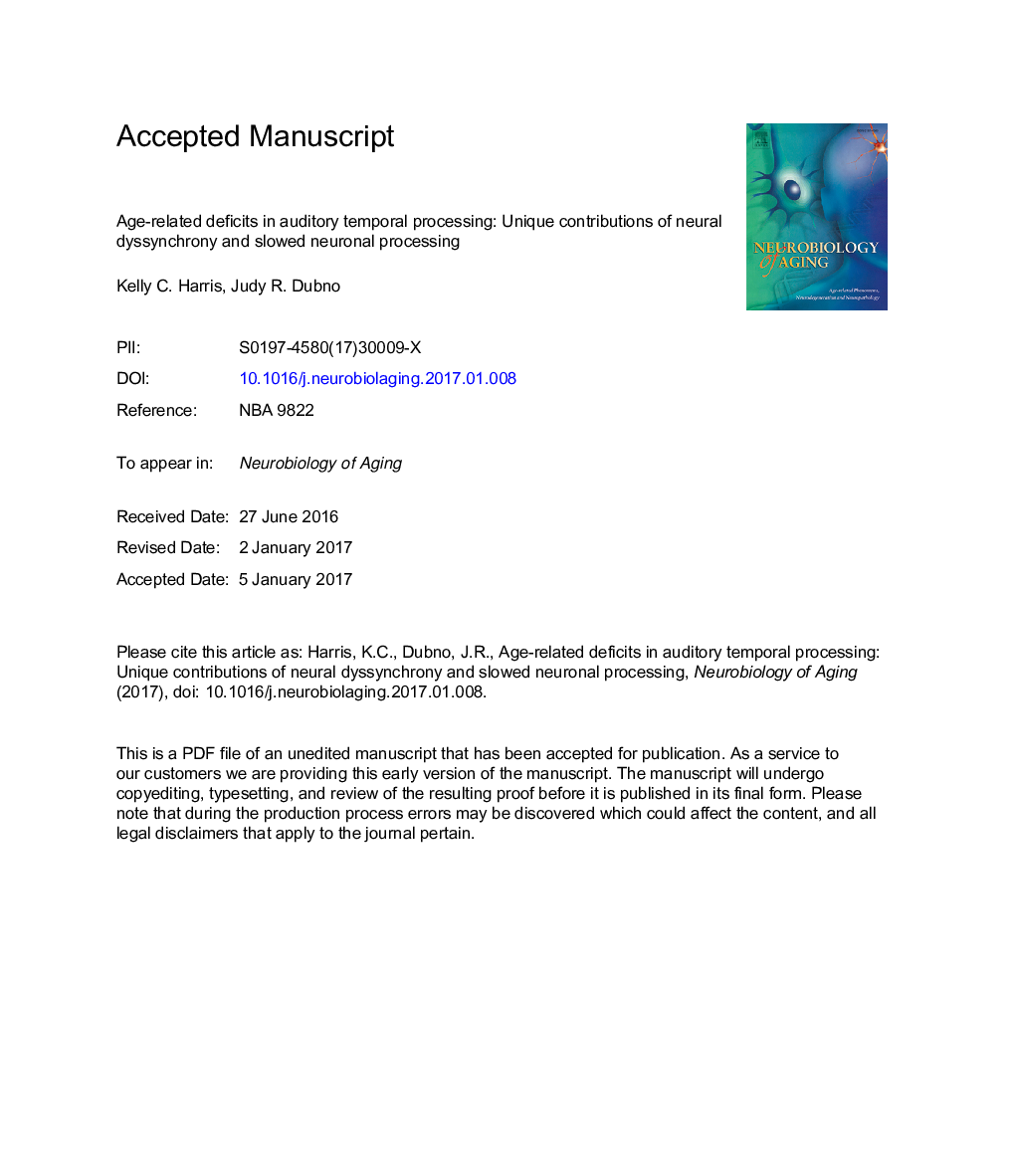| کد مقاله | کد نشریه | سال انتشار | مقاله انگلیسی | نسخه تمام متن |
|---|---|---|---|---|
| 4932617 | 1433531 | 2017 | 32 صفحه PDF | دانلود رایگان |
عنوان انگلیسی مقاله ISI
Age-related deficits in auditory temporal processing: unique contributions of neural dyssynchrony and slowed neuronal processing
ترجمه فارسی عنوان
نقصهای مرتبط با سن در پردازش زمانی شنوایی: مشارکت منحصر به فرد دیسسینکرون عصبی و پردازش عصبی آهسته
دانلود مقاله + سفارش ترجمه
دانلود مقاله ISI انگلیسی
رایگان برای ایرانیان
کلمات کلیدی
سالخورده، هماهنگی عصبی، قفل فاز، فرکانس آلفا پیک، پردازش گوش شنوائی،
ترجمه چکیده
این مطالعه براساس فرضیه ای است که سیستم عصبی مرکزی پیری به طور مداوم توانایی خود را برای پردازش تغییرات آکوستیک سریع که برای تشخیص گفتار مهم است، از دست می دهد. به طور خاص، ما فرض کردیم که نقص های مرتبط با سن در هماهنگی عصبی و فعالیت های نوسان عصبی در افراد مسن به طور مستقل اتفاق می افتد و باعث اختلال پردازش زمانی شنوائی می شود. هماهنگی عصبی تا حد زیادی وابسته به فاز قفل شدن در مسیر شنوایی مرکزی است، که از عصب شنوایی آغاز می شود. در مقابل، ویژگی های رزونانس فعالیت های نوسانی وابسته به یکپارچگی و ساختار اتصالات کروی بلند است. ما فرضیه های ما را با ارزیابی تفاوت های مرتبط با سن در ارتباطات الکتروفیزیولوژیک هماهنگی عصبی و فرکانس نوسان در افراد جوان و سالمند با شنوایی طبیعی و تعیین ارتباطات آنها با اندازه گیری رفتاری از تشخیص فاصله، مورد آزمایش قرار دادیم. مقادیر قفل فاز کوچکتر بود (هماهنگی عصبی ضعیف) و فراوانی پیمان آلفا برای افراد مسن بالاتر از بزرگسالان جوان پایین تر بود و به عنوان آستانه تشخیص شکاف افزایش یافت؛ تغییرات در مقادیر فاز قفل و حداکثر آلفا فرکانس منحصر به فرد پیش بینی آستانه تشخیص شکاف. این اثرات در بخش بزرگی توسط انجمن های بزرگ سالمندان رانده شد. این نتایج نشان می دهد که مکانیزم های عصبی تشخیصی مرتبط با آسیب شناسی اساسی متمایز است که ممکن است در بزرگسالان سالخوردگی متفاوت باشد و باعث کاهش میزان شنوایی می شود.
موضوعات مرتبط
علوم زیستی و بیوفناوری
بیوشیمی، ژنتیک و زیست شناسی مولکولی
سالمندی
چکیده انگلیسی
This study was guided by the hypothesis that the aging central nervous system progressively loses its ability to process rapid acoustic changes that are important for speech recognition. Specifically, we hypothesized that age-related deficits in neural synchrony and neuronal oscillatory activity occur independently in older adults and disrupt auditory temporal processing. Neural synchrony is largely dependent on phase locking within the central auditory pathway, beginning at the auditory nerve. In contrast, the resonance characteristics of oscillatory activity are dependent on the integrity and structure of long range cortical connections. We tested our hypotheses by assessing age-related differences in electrophysiologic correlates of neural synchrony and peak oscillatory frequency in younger and older adults with normal hearing and determining their associations with a behavioral measure of gap detection. Phase-locking values were smaller (poorer neural synchrony) and peak alpha frequency was lower for older than younger adults and decreased as gap detection thresholds increased; variations in phase-locking values and peak alpha frequency uniquely predicted gap detection thresholds. These effects were driven, in large part, by associations in older adults. These results reveal dissociable neural mechanisms associated with distinct underlying pathology that may differentially be present in older adults and contribute to auditory processing declines.
ناشر
Database: Elsevier - ScienceDirect (ساینس دایرکت)
Journal: Neurobiology of Aging - Volume 53, May 2017, Pages 150-158
Journal: Neurobiology of Aging - Volume 53, May 2017, Pages 150-158
نویسندگان
Kelly C. Harris, Judy R. Dubno,
